 W
WThe Apache–Mexico Wars, or the Mexican Apache Wars, refer to the conflicts between Spanish or Mexican forces and the Apache peoples. The wars began in the 1600s with the arrival of Spanish colonists in present-day New Mexico. War between the Mexicans and the Apache was especially intense from 1831 into the 1850s. Thereafter, Mexican operations against the Apache coincided with the Apache Wars of the United States, such as during the Victorio Campaign. Mexico continued to operate against hostile Apache bands as late as 1915.
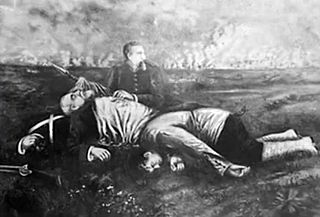 W
WBarrios' War of Reunification was a war initiated by President Justo Rufino Barrios of Guatemala. His goal was to reunify Central America with himself as President. He died in battle on 2 April 1885 and peace was reached on 14 April.
 W
WThe Caste War of Yucatán (1847–1901) began with the revolt of native Maya people of the Yucatán Peninsula against the European-descended population, called Yucatecos. The latter had long held political and economic control of the region. A lengthy war ensued between the Yucateco forces in the northwest of the Yucatán and the independent Maya in the southeast. There was regular raiding between them.
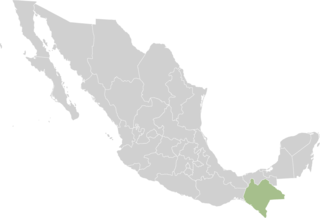 W
WThe Chiapas conflict refers to the 1994 Zapatista uprising, the 1995 Zapatista crisis and their aftermath, and tensions between the indigenous peoples and subsistence farmers in the Mexican state of Chiapas from the 1990s to the present day.
 W
WThe Comanche–Mexico Wars was the Mexican theater of the Comanche Wars, a series of conflicts from 1821 to 1870. There were large-scale raids into northern Mexico by the Comanche and their Kiowa and Kiowa Apache allies, which left thousands of people dead. The Comanche raids were sparked by the declining military capability of Mexico during the turbulent years after it gained independence in 1821, as well as a large and growing market in the United States for stolen Mexican horses and cattle.
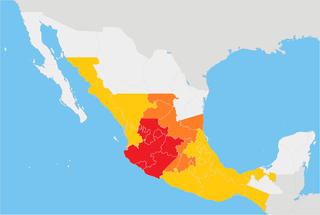 W
WThe Cristero War, also known as the Cristero Rebellion or La Cristiada [la kɾisˈtjaða], was a widespread struggle in central and western Mexico in response to the imposition of secularist and anticlerical articles of the 1917 Constitution of Mexico, which were perceived by opponents as anti-Catholic measures aimed at imposing state atheism. The rebellion was instigated as a response to an executive decree by Mexican President Plutarco Elías Calles to enforce Articles 3, 5, 24, 27, and 130 of the Constitution, a move known as the Calles Law. Calles sought to eliminate the power of the Catholic Church and all organizations which were affiliated with it and to suppress popular religious celebrations in local communities.
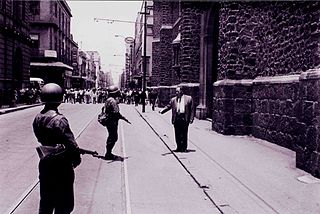 W
WThe Mexican Dirty War refers to the Mexican theater of the Cold War, an internal conflict in the 1960s and 1970s between the Mexican PRI-ruled government under the presidencies of Gustavo Díaz Ordaz, Luis Echeverría and José López Portillo, which were backed by the US government, and left-wing student and guerrilla groups. During the war, government forces carried out disappearances, estimated at 1,200, systematic torture, and "probable extrajudicial executions".
 W
WThe Mexican drug war is the Mexican theater of the global war on drugs, as led by the U.S. federal government, that has resulted in an ongoing asymmetric low-intensity conflict between the Mexican government and various drug trafficking syndicates. When the Mexican military began to intervene in 2006, the government's principal goal was to reduce drug-related violence. The Mexican government has asserted that their primary focus is on dismantling the powerful drug cartels, and on preventing drug trafficking demand along with the U.S. functionaries.
 W
WThe Escobar Rebellion was a conflict in northern Mexico in 1929 during the Maximato, between the government forces of President Emilio Portes Gil and rebel forces under the command of General José Gonzalo Escobar. After some initial success in taking over several key cities in the northern half of the country, the Escobar rebels were decisively defeated in a major battle at Jiménez, Chihuahua, and were eventually swept aside by the advancing government forces under the command of General Calles.
 W
WThe Garza Revolution, or the Garza War, was an armed conflict fought in the Mexican state of Coahuila and the American state of Texas between 1891 and 1893. It began when the revolutionary Catarino Garza launched a campaign into Mexico from Texas to start an uprising against the dictator Porfirio Diaz. Because of this violation of neutrality, the United States Army became involved and assisted the Mexican Army in tracking down Garza's followers. The war was relatively minor compared to other similar conflicts in Mexican history though it has been seen as a precursor to the major Mexican Revolution from 1910 to 1920.
 W
WThe William Walker Filibuster Expedition to Baja California and Sonora occurred in the year of 1853, after a failed attempt by Walker himself to invade Sonora from the Arizona border. William Walker sought to appropriate Sonora, and in his claims he had the support of magnates and the complacency of the United States government. In November 1853 he embarked with two hundred men towards La Paz, where he was able to capture the political chief and proclaimed the independence of the Republic of Baja California, a state that never had recognition nor did it exist in the facts, since Walker never had total control of the peninsula or had the support of the population. Rather, he faced resistance from the army and Mexican civilians, among which the group commanded by Antonio Meléndrez stands out. In spite of being folded in Ensenada and suffering the mutiny of his troops from the United States, Walker proclaimed himself president of the Republic of Sonora, which also included Baja California and that, like its successor, did not have existence in fact nor any recognition. In fact, Walker only reached the territory of Sonora in 1854 when pressured by the navy of the United States and Mexico, he had to flee Ensenada. Before the harassment of Meléndrez and the desertion of another part of his troops, Walker and the remnant of his filibuistero army surrendered in San Diego to the American army. Taken to trial, the judge said he was guilty of violating the Neutrality Law signed between Mexico and the United States after the US invasion of Mexico in 1847. However, Walker was acquitted by the jury.
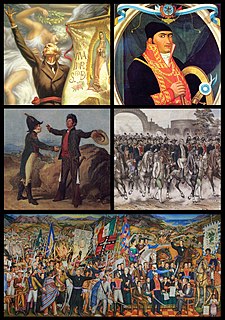 W
WThe Mexican War of Independence was an armed conflict and political process, lasting from 1808 to 1821, resulting in Mexico's independence from Spain. It was not a single, coherent event, but local and regional struggles that occurred within the same time period, and can be considered a revolutionary civil war. Independence was not an inevitable outcome, but events in Spain itself had a direct impact on the outbreak of the armed insurgency in 1810 and its course until 1821. Napoleon Bonaparte's invasion of Spain in 1808 touched off a crisis of legitimacy of crown rule, since he had placed his brother Joseph on the Spanish throne after forcing the abdication of the Spanish monarch Charles IV. In Spain and many of its overseas possessions the local response was to set up juntas ruling in the name of the Bourbon monarchy. Delegates in Spain and overseas territories met in Cádiz, Spain, still under Spanish control, as the Cortes of Cádiz, which drafted the Spanish Constitution of 1812. That constitution sought to create a new governing framework in the absence of the legitimate Spanish monarch. It tried to accommodate the aspirations of American-born Spaniards for more local control and equal standing with Peninsular-born Spaniards. This political process had far reaching impacts in New Spain, during the independence period and beyond.
 W
WThe Las Cuevas War was a brief armed conflict fought mainly between a force of Texas Rangers, commanded by Captain Leander McNelly, and an irregular force of Mexican bandits. It took place in November 1875, in and around Las Cuevas, Tamaulipas. The Texans crossed the Rio Grande into Mexican territory with the purpose of returning stolen cattle to the American side of the river but they were drawn into a battle with local militia forces. When the fighting was over the Mexicans returned the cattle to the Texans.
 W
WThe Long Expedition was an 1819 attempt to take control of Spanish Texas by filibusters. It was led by James Long and successfully established a small independent government, known as the Republic of Texas. The expedition crumbled later in the year, as Spanish troops drove the invaders out. Long returned to Texas in 1820 and attempted to reestablish his control. In October 1821, Long was defeated by Spanish troops, captured and sent to Mexico City where he was killed by a guard.
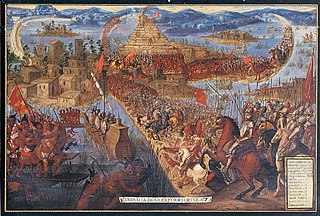 W
WThe Mexican Indian Wars were a series of conflicts fought between Spanish, and later Mexican, Guatemalan, Honduran, Salvadoran and Belizean forces against Amerindians in what is now called Mexico and surrounding areas such as Belize, Guatemala, Honduras, El Salvador and Southern/Western United States. The period begins with Spanish conquest of the Aztec Empire in 1519 and continued until the end of the Caste War of Yucatán in 1933.
 W
WThe Mexican Revolution was a major revolution, including a sequence of armed struggles, lasting roughly from 1910 to 1920, that transformed Mexican culture and government. Its outbreak in 1910 resulted from the increasing unpopularity of the 31-year-long regime of Porfirio Díaz and its failure to find a managed solution to presidential succession. This resulted in a power struggle among competing elites, which created the opportunity for agrarian insurrection. Wealthy landowner Francisco I. Madero challenged Díaz in the 1910 presidential election, and following the rigged results, revolted under the Plan of San Luis Potosí.
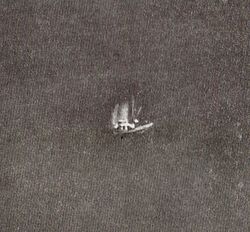 W
WThe Mexico–Guatemala conflict was an armed conflict between the Mexico and Guatemala, in which Mexican civilian fishing boats were fired upon by the Guatemalan Air Force. Hostilities were set in motion by the installation of Miguel Ydígoras as President of Guatemala on March 2, 1958.
 W
WThe Pastry War, also known as the First French intervention in Mexico or the First Franco-Mexican War (1838–1839), began in November 1838 with the naval blockade of some Mexican ports and the capture of the fortress of San Juan de Ulúa in Veracruz by French forces sent by King Louis-Philippe. It ended several months later in March 1839 with a British-brokered peace. The intervention followed many claims by French nationals of losses due to unrest in Mexico. This incident, the first and lesser of Mexico's two 19th-century wars with France, preceded the French invasion of 1861–67 which supported the short reign of Emperor Maximilian I of Mexico whom the Mexicans executed by firing squad at the end of that later conflict.
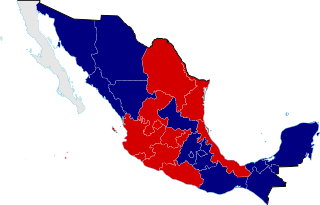 W
WThe War of Reform in Mexico, during the Second Federal Republic of Mexico, was the three-year civil war (1857–1860) between members of the Liberal Party who had taken power in 1855 under the Plan of Ayutla, and members of the Conservative Party resisting the legitimacy of the government and its radical restructuring of Mexican laws, known as La Reforma. The Liberals wanted to eliminate the political, economic, and cultural power of the Catholic church as well as reduce the role of the Mexican Army. Both the Catholic Church and the Army were protected by corporate or institutional privileges (fueros) established in the colonial era. Liberals sought to create a modern nation-state founded on liberal principles. The Conservatives wanted a centralist government, some even a monarchy, with the Church and military keeping their traditional roles and powers, and with landed and merchant elites maintaining their dominance over the majority mixed-race and indigenous populations of Mexico.
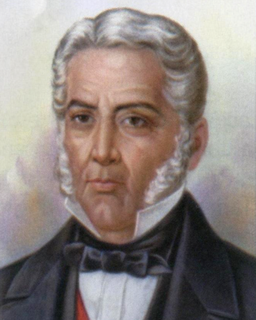 W
WThe Plan of Ayutla was the 1854 written plan aimed at removing conservative, centralist President Antonio López de Santa Anna from control of Mexico during the Second Federal Republic of Mexico period. Initially, it seemed little different than other political plans of the era, but it is considered to be the first act of the Liberal Reform in Mexico. It was the catalyst for revolts in many parts of Mexico, which led to the resignation of Santa Anna from the presidency, never to vie for office again. The next Presidents of Mexico were the liberals, Juan Álvarez, Ignacio Comonfort, and Benito Juárez. The new regime would then proclaim the 1857 Mexican Constitution, which implemented a variety of liberal reforms.
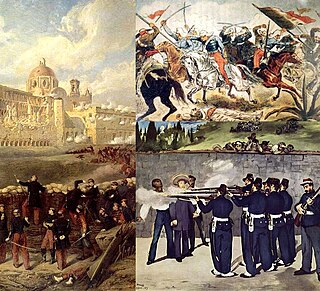 W
WThe Second French Intervention in Mexico, also known as the Second Franco-Mexican War and the Mexican Adventure, was an invasion of Mexico, launched in late 1861, by the Second French Empire (1852–1870). Initially supported by the United Kingdom and Spain, the French intervention in Mexico was a consequence of Mexican President Benito Juárez's imposition of a two-year moratorium of loan-interest payments from July 1861 to French, British, and Spanish creditors. To extend the influence of Imperial France, Napoleon III instigated the intervention in Mexico by claiming that the military adventure was a foreign policy commitment to free trade. The establishment of a European-derived monarchy in Mexico would ensure European access to Mexican resources, particularly French access to Mexican silver. To realize his ambitions without interference from other European nations, Napoleon III of France entered into a coalition with the United Kingdom and Spain.
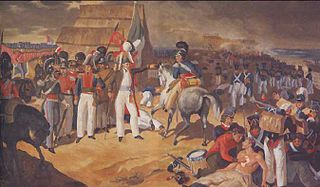 W
WThe Spanish attempts to reconquer Mexico were an effort by the Spanish government to regain possession of its former colony of New Spain, resulting in episodes of war comprised in clashes between the newly born Mexican nation and Spain. The designation mainly covers two periods: the first attempts occurred from 1821 to 1825 and involved the defense of Mexico's territorial waters, while the second period had two stages, including the Mexican expansion plan to take the Spanish-held island of Cuba between 1826 and 1828 and the 1829 expedition of Spanish General Isidro Barradas, which landed on Mexican soil with the object of reconquering Mexican territory. Although the Spanish never regained control of the country, they damaged the fledgling Mexican economy.
 W
WThe following is a timeline of the Mexican War of Independence (1810–1821), its antecedents and its aftermath. The war pitted the royalists, supporting the continued adherence of Mexico to Spain, versus the insurgents advocating Mexican independence from Spain. After of struggle of more than 10 years the insurgents prevailed.
 W
WThe Totoposte Wars were three military conflicts fought in Central America between 1890 and 1906. The First Totoposte War occurred during the presidency of Manuel Lisandro Barillas Bercián in Guatemala, after the overthrow of Salvadoran President Francisco Menéndez by General Carlos Ezeta in El Salvador, which caused the exile of many Salvadorans who took refuge in Guatemala and who requested the help of President Barillas Bercián to stop the armies of Ezeta. The Second Totoposte War arose after the opposition of Guatemalan President Manuel Estrada Cabrera to the integration of Guatemala with the Greater Republic of Central America since Estrada Cabrera was more inclined to work with the government of the United States. The Third Totoposte War occurred in 1906 in similar conditions. In all three wars, the Guatemalan people mockingly referred to the war as the "Totoposte War" because it only served to consume large amounts of this corn-based food, without actually fighting.
 W
WVictorio's War, or the Victorio Campaign, was an armed conflict between the Apache followers of Chief Victorio, the United States, and Mexico beginning in September 1879. Faced with arrest and forcible relocation from his homeland in New Mexico to San Carlos Indian Reservation in southeastern Arizona, Victorio led a guerrilla war across southern New Mexico, west Texas and northern Mexico. Victorio fought many battles and skirmishes with the United States Army and raided several settlements until the Mexican Army killed him and most of his warriors in October 1880 in the Battle of Tres Castillos. After Victorio's death, his lieutenant Nana led a raid in 1881.
 W
WWorld War II, also known as the Second World War, was a global war that lasted from 1939 to 1945. It involved the vast majority of the world's countries—including all the great powers—forming two opposing military alliances: the Allies and the Axis. In a state of total war, directly involving more than 100 million people from more than 30 countries, the major participants threw their entire economic, industrial, and scientific capabilities behind the war effort, blurring the distinction between civilian and military resources. World War II was the deadliest conflict in human history, marked by 70 to 85 million fatalities. Tens of millions of people died due to genocides, premeditated death from starvation, massacres, and disease. Aircraft played a major role in the conflict, including in the use of strategic bombing of population centres, and the only uses of nuclear weapons in war.
 W
WThe Yaqui Uprising, also called the Nogales Uprising, was an armed conflict that took place in the Mexican state of Sonora and the American state of Arizona over several days in August 1896. In February, the Mexican revolutionary Lauro Aguirre drafted a plan to overthrow the government of President Porfirio Díaz. Aguirre's cause appealed to the local Native Americans, such as the Yaqui, who organized an expedition to capture the customs house in the border town of Nogales on August 12.
 W
WThe Yaqui Wars, were a series of armed conflicts between New Spain, and the later Mexican Republic, against the Yaqui Indians. The period began in 1533 and lasted until 1929. The Yaqui Wars, along with the Caste War against the Maya, were the last conflicts of the centuries long Mexican Indian Wars. Over the course of nearly 400 years, the Spanish and the Mexicans repeatedly launched military campaigns into Yaqui territory which resulted in several serious battles and massacres.
 W
WThe Rebellion in Zacatecas of 1835 was part of the Mexican Federalist War between Mexican centralists and federalists during the first half of the nineteenth century during the administration of Antonio Lopez de Santa Anna.